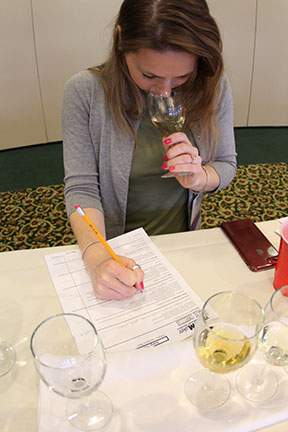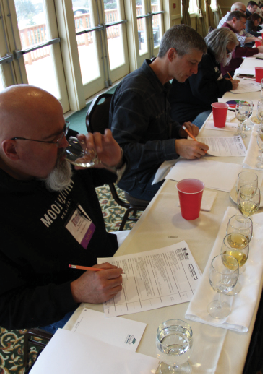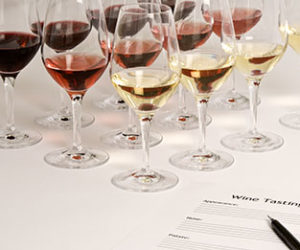 Most winemakers begin by wanting to make an affordable wine through their own efforts. Once they succeed, they focus more on perfecting the finished product. Their next question becomes, “Am I making really good wine? Or lousy wine that I like but no one else would?”
Most winemakers begin by wanting to make an affordable wine through their own efforts. Once they succeed, they focus more on perfecting the finished product. Their next question becomes, “Am I making really good wine? Or lousy wine that I like but no one else would?”
It is at this point that we join clubs and discuss our wines and techniques. But the same question crops up in modified form: “Are we the club members making really good wine? Or lousy wine that we like but no one else would?”
Thus enters the competition. Now, competitions come in several flavors. At one end is the juried competition, primarily directed at commercial wines in which the judges are expected to come to consensus on a final mark on the basis of discussion (and Lord help the wine that falls below 90). At the other end are the club competitions in which Old Fred and Sarah express that they don’t know much about wine, but this here one is sour.
There is, however, a middle ground. Properly constructed competitions at the state or provincial level can apply a fine standard of quality to the assessing of wines. In a properly conducted competition, there are a few rules. Entrants violate them at the peril of having their wines disqualified before the judging even begins. Pay attention; there will be a short quiz at the end of the lesson.
You can eliminate from further consideration the juried competitions, in which the final point score has some absolute meaning. Our interest is in the blind tasting of wines made by amateurs. In a properly conducted, professional wine judging, the points assigned by individual judges are their own “aide-memoire;” they use it only to distinguish between wines, and the numeric score is only significant for that particular judge. As long as there is internal consistency, it matters not if one judge routinely gives 80s and 90s, while another judge, more experienced in the great growths of France, Australia, and California, never rates an amateur wine above 75 unless it is truly exceptional. The point in this is not to sweat the marks; be interested instead in how they were judged and what the results really mean. Internal consistency is the key.
Behind the Scenes
Now pull back the curtain that prevents entrants from seeing what is going on in a competition. The following examples apply to competitions in Canada. Entrants have submitted their wines in anonymous bottles, prescribed by size and color. Any decoration, or identifying characteristics, will usually be cause for disqualification. The stewards take the bottles, with their generic labels affixed with elastic bands or masking tape (no Scotch Tape; it is an admirable product but devilishly hard to remove), check for adherence to the entry rules, rejecting any bottle that does not, and then affix a simple numeric identifier in place of the entry label to which it is cross-referenced.
It is a myth that in a blind competition, the wines are poured off-site; in fact in a large competition (400-plus bottles) this is simply not feasible; since the bottles each have their identifier replaced by a simple numeric code, no judge can know whose wine is whose.
The judges then look at the wines from four perspectives. Each is done for all wines before moving on to the next step, so that there is a horizontal comparison. The process of judging all the wines at each stage before moving on is not necessarily followed in U.S. competitions.
Color. The wine should have a hue and intensity that are appropriate to the class. A rosé for example will have a light color, darker than a blush wine but considerably lighter than a Pinot Noir or Cabernet. Points will be lost for blue tinges or browning in any wines except sherries and related oxidized styles.
Clarity. Believe it or not, occasionally one does come across a wine that is hazy or even muddy. Wines may range from clear to brilliant, with increasing points as a result.
Bouquet. The olfactory organ in the human nose is actually part of the brain and the only part that actually extends beyond the cranial cavity. It is apparently one of the oldest parts of the body in terms of evolution and is directly linked to memory without the intervention of the frontal lobes. The judges take a single, deep sniff of the wine and look for the mental picture that immediately comes to mind. The bouquet, or nose, should be clean, inviting, appropriate to the class and grape, and free of any off-odors such as excess SO2 from sulfur-containing antioxidants and anti-bacterial agents; H2S (the rotten eggs smell); mustiness, from a poorly maintained barrel or a bad cork; excess acetic acid or other volatile acids; oxidation (except in wines of the oxidized class); or other odd smells (fermenting your wine for example in a room where fabric softener is stored can lead to weird odors in the bottle).
Taste, Balance, Quality. Here the intellect gets to have its day. The judges look for a taste that is, again, typical of the class, properly developed and ranging from delicate to full-bodied, again depending on the class. They look for good mouthfeel with a clean “attack” (the first impression), followed by a succession of sensations through the middle and into the finish. In particular the judges look for balance between sweetness, if any, and acidity; an appropriate level of astringency, which can run from high (in the case of aperitif wines) to negligible for delicate white table wines; oakiness appropriate to the class; presence or absence of flavor faults such as excess oxidation, volatile acids, excess oak, yeast autolysis, and so on.
Judging
The judge then assigns a point score to each category. Point scoring can be done in one of two ways, which for the sake of simplicity we will term “subtractive” and “additive.” In the subtractive approach a maximum score of perhaps 20 is possible, but points are deducted for faults such as inappropriate acid, sweetness, tannin or oak; lack of balance; lack of body or flavor; poor or weak aftertaste; and more grievous faults due to bad winemaking or poor-quality ingredients. Some wine judges do not favor this approach because it seems overly mechanistic and does not permit differentiating between an innocuous wine with no major flaws, and an otherwise excellent wine with one or more serious faults.
The additive approach, on the other hand, is usually based out of 100 and assigns, for example, five points for color ranging from zero (unattractive) to five (ideal); 10 points for clarity, ranging from muddy through cloudy to hazy, clear, and brilliant; 25 points for bouquet, where 12 is neutral, below 12 indicates increasing severity of faults, 13 to 20 indicates increasing depth and complexity, and 20 to 25 indicates a wine of excellence, moving to perfection. The final 60 points is for flavor, balance, and quality. Again, 30 points is neutral, below 30 indicates increasingly severe faults, 30 to 40 is a decently made wine with no serious problems, 40 to 50 a quality wine ranging up to superior quality, and above 50 a wine of great rarity and quality.
In a large competition with multiple judges each judge may examine in depth, and comment upon, a subset of the total wines. He then normally “pulls forward” the wines considered worthy of finalist consideration; “pushes back” those that have obvious faults, and leaves in the middle the “also rans.” To ensure that no wine can be eliminated due to the bias of a single judge, it is standard practice in many competitions for the other judges to then taste all of the rejects (all those not pulled forward) and, without challenge, pull forward any considered to be contenders. In the third step, the judges discuss the strong and weak points of all those pulled forward, and then mark a secret ballot with their final opinion of the relative merit of all contenders. In medal-based competitions, this indicates the medal rating they consider for each wine, be it gold, silver, bronze, or none.
The chief steward of the competition then uses a mathematical formula to determine final placing. If there are enough judges, some competitions discard the highest and lowest score, as is done in some sports competitions, prior to final score determination.
Stacking the Deck
Now, if you are planning to win competitions, there are ways you maximize your chances. The easiest way to win recognition is simply to enter the classes that are least subscribed. This, however, is no guarantee of medals; it is not at all unheard of for some competitions to result in no medals in one or more classes, indicating that the winners were the best of an undistinguished lot. Other classes might result in multiple gold medals, meaning that even the lowest-rated of the finalists was, on its own, a very good wine. What should you do to make sure that your wine is one of the finalists?
First, read the instructions carefully, and then read them again. Follow them to the letter. If the rules call for a particular style and size of bottle, do not try to save trouble by using a different one. In most competitions this will result in disqualification of the entry without further consideration. Many competitions require that the bottle be free of all identifying marks, except for the official competition label, affixed as directed. Again, seemingly innocuous marks such as a dab of paint or an embossed bottle will likely ensure that your wine never sees the show bench. In some U.S. states such as California, that is not always the case. But the point is the same; follow instructions. Fill out all documentation, including the label, completely.
If the wine is to be shipped to the competition, use a sound, rigid outer container, and either protect the bottles by thoroughly wrapping each one in bubble wrap, or use one of the special-purpose bottle shipping containers with foam packing and molded space for the bottles. Many shippers do not accept wine if labeled as such but accept descriptions such as “test samples; non-toxic.”
Sweet Rewards
What should you expect to get back after the competition? Hopefully a medal and certificate, of course. But as well, and even if you don’t win, you should receive detailed judges’ comments indicating the relative merits of your wine.
What you should not necessarily expect is a detailed point rating, since as noted some competitions do not release them as a matter of policy, and moreover they are not very illuminating. While some will claim that good judges will be extremely close in their point scores, no less an authority than The Oxford Companion to Wine observes that “When tasting wine, the nuances of Colour, Aroma, Flavour, and Taste, the interplay of alcohol, aldehydes, esters, and acids, the location, temperature, even one’s companions, have such complicated effects that, whilst providing much of the enjoyment of wine, they make the idea of describing a wine numerically seem oversimplified at best, ridiculous at worst.”
Competitions are an excellent way of obtaining impartial feedback on the quality of your product. Winning an award in a major competition is a real thrill, a confirmation of your prowess as a winemaker, and carries with it bragging rights with your club colleagues and other friends. Best of luck!






